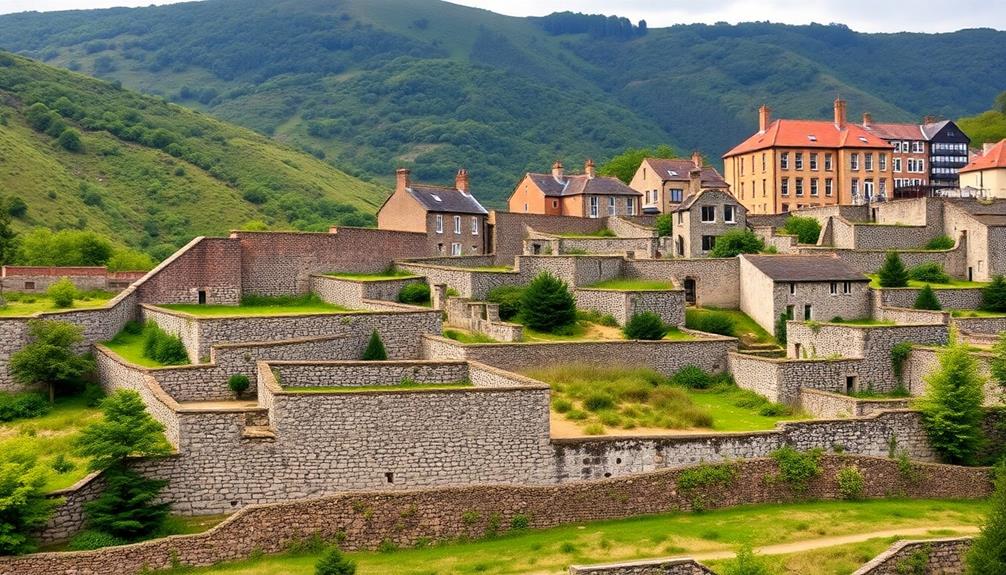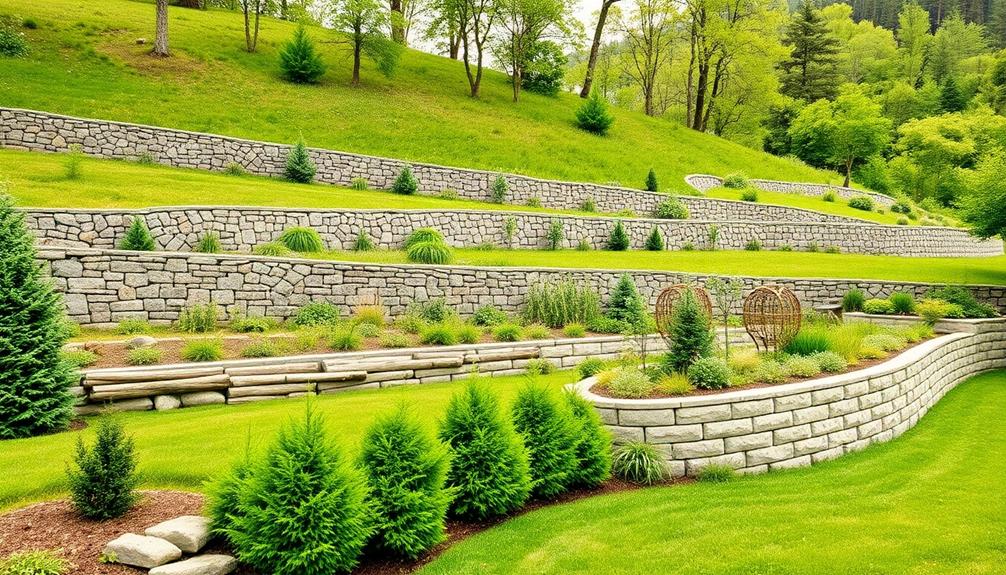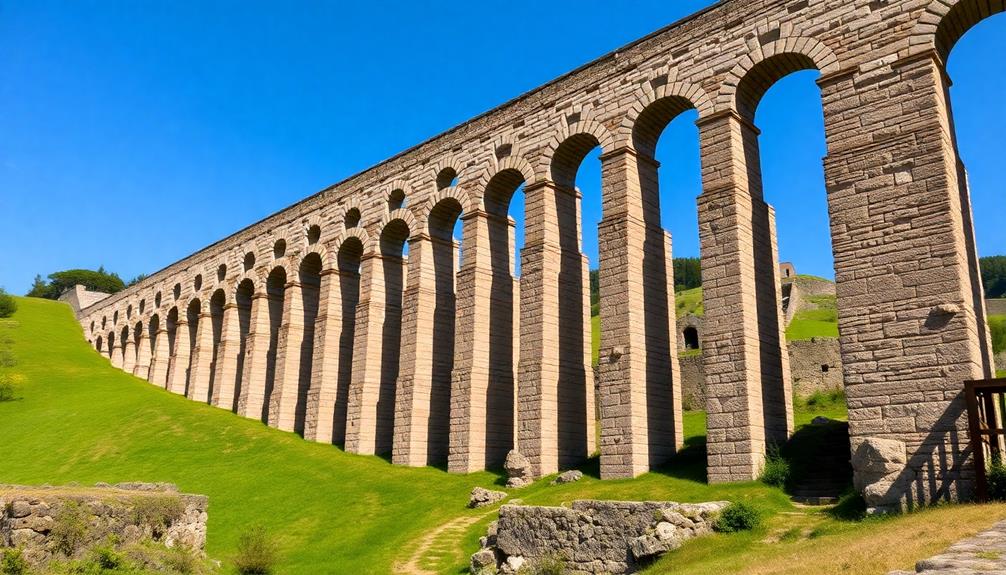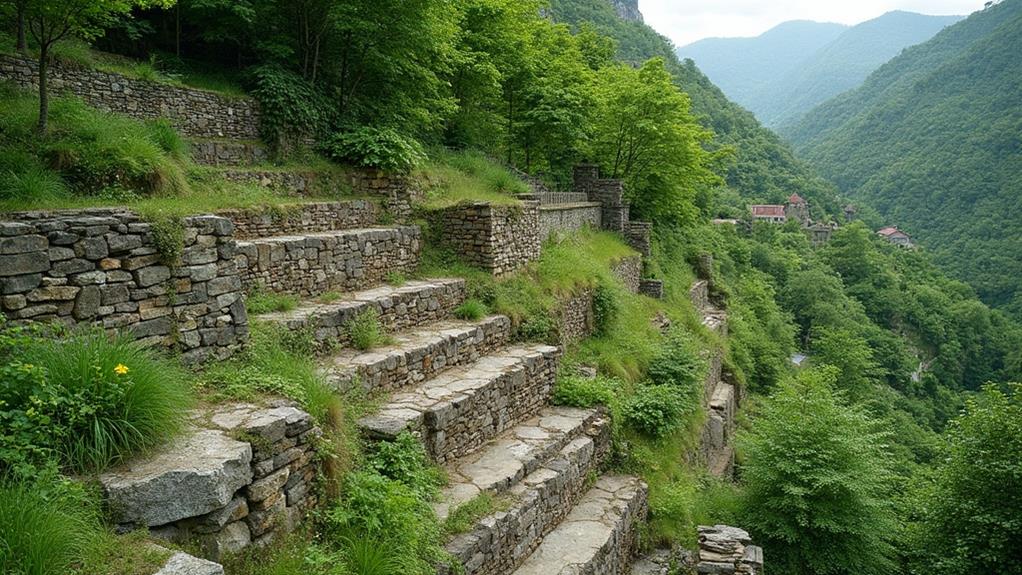The historical development of retaining wall techniques underscores a dynamic journey from ancient ingenuity to modern engineering advancements. Early civilizations such as the Mesopotamians and Incas utilized natural materials like mud bricks and interlocking stones to create stable terraces and structures, aligning with the landscape. Roman engineering innovations introduced opus caementicium and stone-and-mortar walls, incorporating arches and vaults for improved load distribution. Contemporary methods have evolved to include modular designs, geosynthetics, and sustainable materials like recycled aggregates, optimizing land use and ecological integration while ensuring durability. Exploring these advancements reveals a deep-rooted tradition in engineering excellence and environmental harmony.
Table of Contents
ToggleWalls Contractor Highlights
- Ancient civilizations used local materials like mud bricks and stone for agricultural and architectural retaining walls.
- Roman engineering advanced retaining walls with techniques like opus caementicium and arches for stability and durability.
- Modern retaining walls incorporate geosynthetics and recycled materials for eco-friendly construction and effective soil stabilization.
- Computational modeling aids in designing retaining walls to withstand stressors and suit diverse landscapes.
- Retaining walls have evolved to enhance land utilization, erosion control, and aesthetic integration with natural surroundings.
Evolution of Retaining Walls

The evolution of retaining walls reflects a trajectory from ancient construction methods, where materials like stone and earth were meticulously aligned to create basic, yet effective structures, to the intricate innovations seen in contemporary engineering design. This progression has been substantially enhanced by advancements in technology and materials, allowing for the development of walls that are not only stronger and more durable but also aesthetically versatile, integrating seamlessly into modern landscapes.
Boulder walls have become a popular choice in landscaping for their natural, rustic aesthetics and eco-friendly benefits. As today's engineers utilize cutting-edge composite materials and geotechnical approaches, they continue to push the boundaries of design, ensuring that retaining walls serve both functional and artistic purposes in various environments.
Ancient Wall Construction Methods
Exploring the origins of retaining wall technology reveals the ingenuity of ancient civilizations in addressing land stability and irrigation challenges. The roots of these constructions can be traced back to the terraces of Mesopotamia, where the Sumerians first devised retaining mechanisms to cultivate crops along the Tigris and Euphrates floodplains. These early techniques primarily employed mud bricks and local stone, skillfully assembled to withstand both time and nature's forces, while providing essential agricultural stability that sustained burgeoning populations.
In regions like Egypt, evidence shows that retaining walls not only supported agricultural purposes but also monumental architecture. The Egyptians ingeniously utilized limestone and sandstone in their construction, implementing precise cutting techniques that facilitated enduring structures along the Nile.
Additionally, the Incas in South America excelled in dry stone walling, embodying a sophisticated understanding of interlocking stone techniques without mortar. Their meticulous craftsmanship around Machu Picchu exemplifies retention methods that both harmonize with and enhance mountainous terrain.
Around the world, these ancient civilizations laid foundational principles for modern geotechnical engineering, emphasizing harmony between man-made structures and natural landscapes. These timeless techniques were essential not only for agrarian productivity but also for the cultural identities they helped build, ensuring a legacy that continues to inspire current practices.
Innovations in Engineering Design
Building upon the foundational techniques of ancient civilizations, modern engineering has dramatically revolutionized retaining wall designs to meet contemporary demands. With paradigms shifting from manually-hewn stone to sophisticated structural systems, engineers have introduced innovative design solutions to address diverse environmental and structural challenges.
The development of modular retaining walls, for instance, provides flexible solutions that adapt to various landscapes and soil conditions, enhancing longevity and efficiency. By integrating geotechnical engineering principles, walls are now designed with meticulous attention to factors such as drainage, load factors, and foundational support.
One of the key advancements is the utilization of precise computational modelling. This technology allows engineers to simulate potential stressors and environmental impacts before construction begins, ensuring structural integrity and cost-efficiency. Complex engineering calculations govern the relationship between the wall and earth pressures, particularly in earthquake-prone regions where dynamic considerations are paramount.
Additionally, terraced retaining wall systems represent an innovation intertwining landscape architecture with engineering. Critically, these innovations echo a broader engineering ethos—where the need for resilient infrastructure aligns with community inclusivity and safety. As retaining wall technology advances, it cultivates a sense of collective empowerment, enabling societies to sustain and protect their built environments against multifaceted challenges.
Modern Materials and Approaches
Advancements in materials science have greatly propelled the evolution of retaining wall construction, offering robust solutions tailored to modern engineering demands. These innovations have revolutionized traditional methodologies, enhancing longevity, functionality, and environmental compatibility. Contemporary construction now embraces a plethora of innovative materials and techniques, establishing a new paradigm in retaining wall engineering.
Geosynthetics: These synthetic materials, such as geogrids and geotextiles, are engineered to reinforce and stabilize soil structures. Their introduction has enabled a reduction in construction costs while improving structural integrity, especially in challenging terrains.
Recycled Materials: Increasing environmental awareness has led to more sustainable construction practices. The incorporation of recycled aggregates, such as crushed concrete, not only reduces carbon footprints but also capitalizes on abundant industry by-products to create eco-friendly retaining solutions.
Composite Materials: Advances in composite technology have seen the emergence of materials that combine multiple elements to leverage collective strengths, yielding walls with heightened durability and resistance to environmental stressors.
In the ever-evolving landscape of construction, staying abreast of these material advancements allows engineers and architects to create inclusive, sustainable spaces that resonate with their communities, fostering a sense of collective progress and forward-thinking design.
Benefits

Retaining walls offer significant benefits that extend beyond their primary role of enhancing structural stability. Boulders can battle gravity effectively, transforming previously unusable spaces into functional and visually appealing areas.
Enhanced Structural Stability
When constructing retaining walls, the enhanced structural stability they provide is of paramount importance, particularly in areas prone to soil erosion and varying load conditions. Through centuries of innovation, retaining walls have evolved to guarantee not only their longevity but also their capability to withstand diverse environmental challenges.
This stability is indispensable for maintaining the safety and integrity of the structures they support, as well as for preventing potential hazards related to soil displacement. The benefits are numerous, providing communities with a sense of security and trust in the structures that fortify their landscapes.
Key benefits of enhanced structural stability in retaining wall systems include:
- Increased Load-Bearing Capacity: Modern retaining walls are engineered to support significant weight, accommodating both the static and dynamic pressures exerted by the earth and human infrastructure, thereby minimizing risks related to soil collapse and structural failure.
- Durability and Resistance: Advanced materials and construction techniques contribute to the durability of retaining walls, offering resistance against natural phenomena such as heavy rainfall, seismic activities, and seasonal temperature variations.
- Reduced Maintenance Costs: With improved stability, these structures require less frequent repairs and reinforcements, reducing long-term maintenance costs and guaranteeing financial sustainability for communities and stakeholders involved.
These attributes reinforce the sense of belonging and safety communities seek in their environments.
Improved Land Utilization
Utilizing land effectively is a critical benefit of retaining wall systems, especially in regions where space is constrained or topography is challenging. In urban areas, where every square meter is precious, these engineered structures transform otherwise unusable terrain into functional, productive spaces. Retaining walls support the pursuit of optimized ground use, in this manner fostering community development and cohesion.
The strategic implementation of retaining walls allows for the creative transformation of slopes and undulating landscapes into flattened, viable areas. This conversion not only maximizes available space for construction and agricultural activities but also permits the integration of infrastructure that meets the needs of burgeoning populations.
By enabling multi-level terraces and gardens, these structures enrich the environment and enhance the aesthetic appeal of surrounding areas, often becoming focal points for communal activities.
Consequently, retaining wall systems facilitate sustainable land management practices that strengthen bonds within communities. As land becomes more usable and accessible, individuals experience a sense of belonging, grounded in their shared inhabitation of adapted spaces. Through these developments, retaining walls contribute to a seamless, harmonious integration of built and natural environments, in this way advancing societal progression and well-being.
Erosion Control Measures
Erosion control is an integral benefit of retaining wall systems, offering a practical solution for preventing soil loss and degradation in vulnerable landscapes. Retaining walls serve as steadfast barriers that considerably reduce the impact of soil erosion by stabilizing steep terrains and protecting them from the adverse effects of water runoff and wind erosion. These walls create a sense of security and belonging, reassuring communities that their landscape is thoughtfully managed and preserved.
The benefits of employing retaining walls for erosion control are multifaceted:
- Soil Stabilization: By preventing soil movement, retaining walls enhance the integrity of slopes, ensuring that soil stays where it is needed, promoting a stable environment.
- Water Management: These structures channel water effectively, minimizing the potential for water-induced erosion and helping manage natural water flow patterns to nurture gardens and crops.
- Versatile Adaptation: Retaining walls are adaptable to different terrains, providing personalized solutions to diverse landscapes, ensuring every community's unique geography is respected.
Aesthetic Landscape Integration
Incorporating retaining walls into a landscape allows for a seamless integration that enhances the natural beauty and functionality of the area. This strategic approach not only serves practical purposes but also adds significant aesthetic value, transforming spaces into harmonious extensions of their natural surroundings.
Retaining walls, when thoughtfully designed and implemented, offer a curated environment where nature and human ingenuity meet, offering a sense of belonging to those who experience these spaces. The synergy between the structural elements and the natural environment is crucial, bringing balance and unity to landscapes.
Beyond structural integrity, retaining walls contribute to the visual appeal, creating layers of texture and depth within outdoor spaces. They can define distinct areas within a garden or park, guiding visitors and framing views. The choice of materials, whether stone, timber, or concrete, affects the overall aesthetic, aligning with the existing landscape's character.
Additionally, they provide opportunities for planting and artistic elements, fostering biodiversity while accentuating the site's visual narrative. This thoughtful integration not only enhances the appearance but also promotes sustainability, creating inviting and inclusive spaces that reflect both individual and collective identities within the shared environment.
Ancient Roman Engineering Methods

Ancient Roman engineering feats have left a lasting legacy on modern structural practices, particularly noted for their innovative use of materials and construction techniques such as Opus Caementicium, which was an early form of concrete, durable and capable of standing the test of time. Their stone and mortar walls provided critical insights into stability and durability, while their development of the arch and vault structures demonstrated a profound understanding of load distribution, which has influenced countless architectural designs throughout history. Below is a table summarizing some key aspects of these techniques:
| Technique | Material Used | Structural Benefit |
|---|---|---|
| Opus Caementicium | Concrete-like Mix | Longevity and Strength |
| Stone Walls | Stone and Mortar | Stability and Load Bearing |
| Mortar Walls | Mortar with Aggregate | Enhanced Structural Cohesion |
| Arch Structures | Stone/Brick | Efficient Load Distribution |
| Vault Structures | Concrete or Stone | Spans Large Spaces |
This concise representation underscores the enduring influence of Roman engineering on contemporary retaining wall solutions.
Use of Opus Caementicium
The remarkable durability and strength of Roman architecture owe much to their pioneering use of opus caementicium, a hydraulic concrete that revolutionized construction during the ancient era. This innovative material enabled the Romans to create robust and long-lasting retaining walls across their expansive empire, inspiring admiration and fostering a sense of belonging within its communities.
Opus caementicium's ingenious composition combined lime mortar, water, volcanic ash, and small stones, leading to structures capable of withstanding environmental wear for centuries. This method of construction provided a blueprint for modern engineering, demonstrating the timeless applicability of Roman ingenuity.
Despite its ancient origins, opus caementicium incorporated key concepts that continue to resonate in modern construction practices:
- Hydraulic Properties: The inclusion of volcanic ash in opus caementicium conferred the ability to set underwater, distinguishing it from other contemporaneous building techniques.
- Adaptable Usage: This material could be molded into diverse forms, allowing architects to adapt to various landscapes and functional requirements.
- Enhanced Longevity: The inherent durability of opus caementicium guaranteed that Roman structures could endure the ravages of time, enabling their empire to withstand both natural and man-made challenges.
Thus, opus caementicium remains an enduring document to Roman engineering prowess and communal foresight.
Stone and Mortar Walls
Building upon their foundation of innovative techniques, Roman engineers skillfully employed stone and mortar to construct formidable retaining walls that precisely balanced form and function. These pioneering structures demonstrated the Romans' advanced understanding of materials and geometry, allowing them to endure the test of time.
Stone, renowned for its structural capacity and availability, was meticulously selected and arranged in courses to establish a solid base. Mortar, composed of lime and pozzolanic ash, was ingeniously utilized to bind these stones together, enhancing both stability and durability. This fusion of elements resulted in retaining walls that were not only practical but also pleasing to the eye.
The Romans' expertise extended beyond mere construction; they possessed a keen awareness of the geological conditions and site-specific requirements. The design of these walls considered the earth pressures and anticipated loads, ensuring both safety and longevity. The harmonious integration of engineering prowess and aesthetic consideration underscores the Romans' contributions to civil engineering.
As we explore these ancient methods, we connect with the legacy of an empire that has left an indelible mark on the built environment, reminding us of the enduring power of the human spirit to master and mold the natural world.
Arch and Vault Structures
With unparalleled ingenuity, the Romans transformed the landscape of civil engineering through their mastery of arch and vault structures. These innovations allowed them to construct formidable retaining walls and other monumental edifices that stand resiliently even today.
The strategic implementation of arches and vaults not only optimized space and load distribution but also ushered in a new era of architectural creativity, blending functionality with artistry. These structures are integral in the development of engineering techniques that aspire to symbiosis with their surroundings, instilling a sense of belonging and durability in a changing world.
Consider the following aspects of Roman arch and vault methods:
- Load Distribution: Arches efficiently spread weight across the structure, alleviating pressure on specific points and enhancing overall stability, pivotal for sustaining heavy loads from the soil and structures above.
- Material Efficiency: The strategic use of locally sourced materials, such as stone and concrete, reduced the need for excessive resources while maximizing the strength of the construction—an environmentally conscious practice even in ancient times.
- Aesthetics and Functionality: Roman engineering harmoniously combined beauty with utility. The elegant curves of arches and vaults not only provided structural advantages but also contributed to aesthetically pleasing environments in urban and rural landscapes.
Walls Contractor FAQ
What Modern Technologies Are Used to Improve Retaining Wall Efficiency?
Modern technologies enhancing retaining wall efficiency include geosynthetic reinforcement, modular block systems, and advanced drainage solutions. These innovations promote structural integrity, environmental sustainability, and community resilience, aligning with shared goals for safer, more sustainable infrastructure development.
How Do Climate Changes Impact the Durability of Retaining Walls?
Climate changes impact retaining wall durability through increased exposure to extreme weather events, temperature fluctuations, and soil erosion. These factors necessitate enhanced materials and design strategies to guarantee resilience, fostering a community of innovation and adaptation in construction practices.
What Are the Cost Implications of Different Retaining Wall Materials?
Different retaining wall materials have varied cost implications, influenced by factors like material longevity, maintenance needs, and installation complexity. Natural stone may be pricier upfront, while concrete and timber offer more budget-friendly solutions with differing long-term costs.
How Do Different Soil Types Affect Retaining Wall Construction?
Soil type profoundly influences retaining wall construction, affecting stability, drainage, and material choice. Cohesive soils, like clay, demand specific reinforcement, while granular soils require efficient drainage systems to prevent erosion. Proper soil assessment guarantees successful, durable structures.
What Considerations Are Necessary for Aesthetic Design in Retaining Walls?
When designing aesthetically pleasing retaining walls, consider texture, color, and shape harmonization with the surroundings. Balance functionality with visual appeal to guarantee integration into the environment, promoting community engagement and a sense of place.







